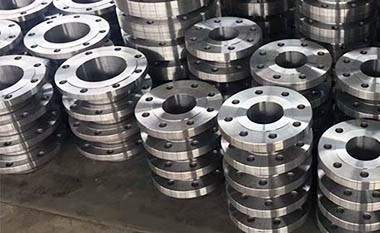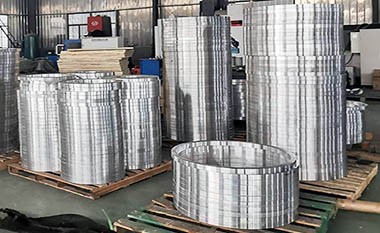2618 aluminum forging
2618 aluminum alloy is a high-performance aluminum alloy known for its excellent strength, good ductility, and corrosion resistance, making it particularly suitable for high-temperature and high-stress environments.
The high-temperature resistance, high strength, and corrosion resistance of 2618 aluminum forgings allow them to maintain excellent performance even under extreme conditions, commonly used in high-demand fields such as aerospace and motorsports.
2618 is a heat-treatable, heat-resistant aluminum alloy, with a working temperature of up to 250°C. It is used to manufacture structural components for supersonic aircraft that operate for long periods, such as fuselage and wing skin frames, tail assemblies, as well as low-speed aircraft parts with working temperatures not exceeding 150°C, and jet engine components with working temperatures not exceeding 250°C.
HC Aluminum can supply 2618 aluminum forgings, plates, and other products according to your custom sizes. Our forging processes include open-die forging and ring rolling. A full range of common forging shapes for 2618 is available and can be customized to customer specifications.
Characteristics of 2618 Aluminum Forging
- 1. Strength and Toughness: 2618 aluminum alloy has very high tensile and yield strength, and its mechanical properties can be significantly enhanced through heat treatment, making it suitable for withstanding high loads and impacts.
- 2. Corrosion Resistance: This alloy has good corrosion resistance, making it suitable for use in harsh environments, effectively resisting oxidation and corrosion.
- 3. Machinability: It possesses excellent machinability, making it easy to process into various complex shapes through forging and cutting.
- 4. Good Ductility: The ductility of this alloy allows it to be processed into various complex shapes through forging and extrusion techniques.
- 5. High-Temperature Performance: 2618 aluminum alloy can maintain good mechanical properties at working temperatures of up to 250°C, making it suitable for applications in high-temperature environments.
Chemical composition of 2618 aluminum forgings
| Element | Composition(%) |
| Aluminum (Al) | 93.0-95.0 |
| Copper (Cu) | 2.20-2.80 |
| Iron (Fe) | 0.30 max |
| Magnesium (Mg) | 1.50-2.50 |
| Manganese (Mn) | 0.10 max |
| Silicon (Si) | 0.50-0.90 |
| Zinc (Zn) | 0.20 max |
| Titanium (Ti) | 0.10 max |
| Chromium (Cr) | 0.10 max |
| Other Elements | 0.05 max each, 0.15 max total |
Material properties for 2618 aluminum forging
| Material Specification | Density (g/cm3) | Melting Point (°C) | Thermal Conductivity (W/mK) | Coefficient of Thermal Expansion (10-6/K) |
| DTD 717A 2618A-T6 Forging Stock and Forgings | 2.78 | 515-635 | 127 | 23.2 |
| DTD 731B 2618 T6 Forging Stock and Forgings | 2.78 | 515-635 | 127 | 23.2 |
| AMS 4132 2618-T61 Die & Hand forgings | 2.78 | 515-635 | 127 | 23.2 |
Applications of 2618 Aluminum Forgings
1. Aerospace
2618 aluminum alloy is widely used to manufacture key structural components of supersonic aircraft due to its high strength and high-temperature performance.
- Fuselage and Wing Skin Frames: In supersonic aircraft, the fuselage and wings need to withstand significant aerodynamic loads and high-temperature environments. 2618 aluminum forgings provide the required strength and stiffness.
- Tail Assembly and Other Structural Components: Tail components endure tremendous airflow pressure during high-speed flight. Using 2618 aluminum alloy can effectively reduce weight while maintaining the integrity and stability of the structure.
- Protective Materials: Under extreme conditions, the wear-resistant and corrosion-resistant properties of 2618 aluminum make it an effective protective material, extending the lifespan of the aircraft.
2. Jet Engines
- Compressor Components: The working environment of a compressor is complex, involving high temperatures and pressures. 2618 aluminum alloy can maintain its structural strength and stability at working temperatures up to 250°C.
- Turbine Components: Turbine components require good thermal stability. The characteristics of 2618 aluminum make it excel in this application, effectively resisting thermal deformation and fatigue damage.
3. Automotive Aluminum Forgings
In the field of high-performance racing, the lightweight and high-strength properties of 2618 aluminum alloy make it an important material choice.
- Lightweight Structural Components: In racing cars, reducing body weight is key to improving performance. 2618 aluminum forgings can significantly reduce weight while ensuring strength, enhancing the vehicle's acceleration and handling.
- High-Strength Components: Cars must endure massive dynamic loads during high-speed motion. The high-strength characteristics of 2618 aluminum alloy ensure the safety and stability of the race car, enabling it to withstand extreme conditions.
Processing Characteristics of 2618 Aluminum
1. Forging Characteristics
- Hot Forging: 2618 aluminum alloy is suitable for hot forging. At high temperatures (typically 400-500°C), the alloy's ductility is significantly improved, making it easier to shape during forming. Hot forging can enhance the material's microstructure and improve its mechanical properties.
- Cold Forging: Although 2618 aluminum alloy can also be cold forged, its forming performance at room temperature is relatively poor. Therefore, cold forging is generally not recommended unless there are very high precision requirements.
2. Heat Treatment
Aging Treatment: The strength of 2618 aluminum alloy can be significantly improved after aging treatment, with common heat treatment methods including T6 and T651.
- T6 Treatment: This involves solution heat treatment followed by aging. Solution treatment is typically conducted at around 500°C, followed by rapid cooling to maintain the alloy in a supersaturated state. Aging is then performed at room temperature or slightly elevated temperatures for several hours to days to promote the formation of precipitate strengthening phases, enhancing material strength.
- T651 Treatment: This involves machining on the T6 basis to remove surface stresses, further improving the material's strength and durability. This treatment is suitable for applications requiring precise dimensions and high strength.
Machining: The machining performance of 2618 aluminum alloy after heat treatment is good, allowing for the manufacture of high-precision components.
Welding: Although the weldability of 2618 aluminum alloy is relatively poor, welding can still be performed under appropriate conditions. Common welding methods include TIG and MIG welding.


